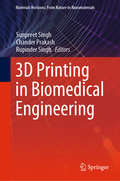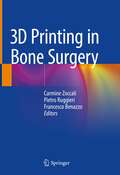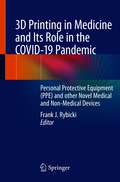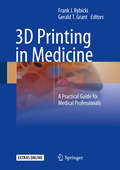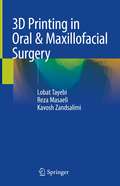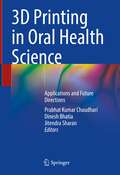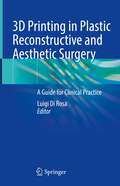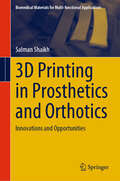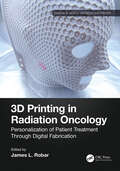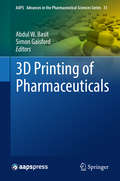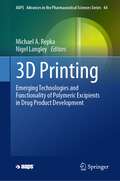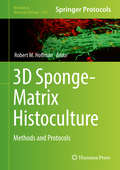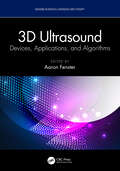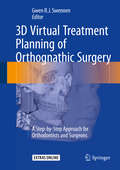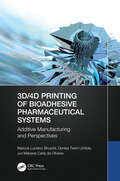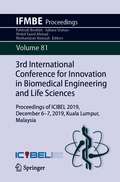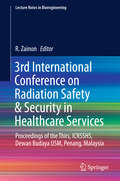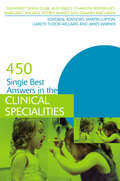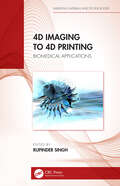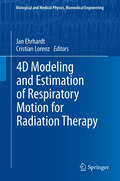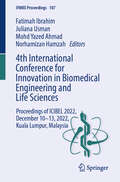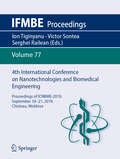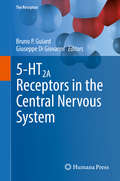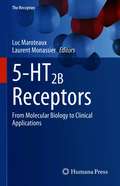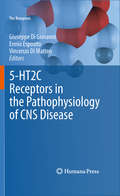- Table View
- List View
3D Printing in Biomedical Engineering (Materials Horizons: From Nature to Nanomaterials)
by Rupinder Singh Chander Prakash Sunpreet SinghThis book gives a comprehensive overview of the rapidly evolving field of three-dimensional (3D) printing, and its increasing applications in the biomedical domain. 3D printing has distinct advantages like improved quality, cost-effectiveness, and higher efficiency compared to traditional manufacturing processes. Besides these advantages, current challenges and opportunities regarding choice of material, design, and efficiency are addressed in the book. Individual chapters also focus on select areas of applications such as surgical guides, tissue regeneration, artificial scaffolds and implants, and drug delivery and release. This book will be a valuable source of information for researchers and professionals interested in the expanding biomedical applications of 3D printing.
3D Printing in Bone Surgery
by Pietro Ruggieri Carmine Zoccali Francesco BenazzoFilling a gap in the literature, this is the first book to comprehensively discuss 3D printing applied to bone surgery. It provides both the scientific basics and practical applications, with a special focus on 3D-printed, custom-made titanium prostheses (3DPCMP) used for bone reconstruction following tumor resection. Initially applied to pelvic and scapular prostheses – because of their of highly complex anatomy – this technology is increasingly being adopted in other fields of orthopedics, such as limb surgery, traumatology and degenerative diseases. Throughout the book, experts from various fields share their knowledge, describing 3D printing applied to the reconstruction of different bone segments, reviewing each application and comparing it with traditional reconstruction. They also present real-world case studies from their clinical practice. Uniquely responding to the growing interest surrounding 3D printing for bone reconstruction, this book is invaluable for orthopedic, neuro- , head and neck as well as maxillofacial surgeons wishing to gain insights into this new and promising field.
3D Printing in Medicine and Its Role in the COVID-19 Pandemic: Personal Protective Equipment (PPE) and other Novel Medical and Non-Medical Devices
by Frank J. RybickiThis book describes how “makers” with no medical experience became and remain clinically important because they utilized 3D printing to produce supplies for healthcare, including medical and non-medical devices, and to improve the quality of life for patients with COVID-19 and those who care for them. It shows how 3D printing became vital during the pandemic due to its broad availability and the inherently digital nature of the work that enables thriving digital exchanges and work in isolation. Subsequent chapters highlight some of the “maker” communities' efforts that made a difference in their part of North America. Each contribution describes the unique experiences, challenges, and successes.While this book is written and edited mostly from a medical perspective, additional input from medical engineers, administrators, attorneys, and public safety officials enables a broad perspective to highlight some of the ingenuity from the North American 3D printing community who responded to the initial case volumes of COVID-19.
3D Printing in Medicine: A Practical Guide for Medical Professionals
by Frank J. Rybicki Gerald T. GrantThis book describes the fundamentals of three-dimensional (3D) printing, addresses the practical aspects of establishing a 3D printing service in a medical facility, and explains the enormous potential value of rendering images as 3D printed models capable of providing tactile feedback and tangible information on both anatomic and pathologic states. Individual chapters also focus on selected areas of applications for 3D printing, including musculoskeletal, craniomaxillofacial, cardiovascular, and neurosurgery applications. Challenges and opportunities related to training, materials and equipment, and guidelines are addressed, and the overall costs of a 3D printing lab and the balancing of these costs against clinical benefits are discussed. Radiologists, surgeons, and other physicians will find this book to be a rich source of information on the practicalities and expanding medical applications of 3D printing.
3D Printing in Oral & Maxillofacial Surgery
by Lobat Tayebi Reza Masaeli Kavosh ZandsalimiThis book is a comprehensive guide to 3D printing and 3D bioprinting methods and their application in oral and maxillofacial surgeries. Among the 3D printing methods considered are fused deposition modeling, selective laser sintering, photopolymer jetting, powder binder printing, and stereolithography, while the coverage of 3D bioprinting encompasses inkjet, microextrusion, and laser techniques. In each case, the relevance of the technique to oral and maxillofacial surgery is explained. In addition, the available inks and bioinks for 3D printing are reviewed. The roles of soft and hard tissue printing in oral and maxillofacial tissue engineering and the use of 3D printing in multi- and interfacial tissue engineering are then examined in depth. The particular value of 3D printing in the treatment of critically sized defects is discussed separately. Finally, up-to-date information is provided on guided tissue/bone regeneration using 3D printing. The book will be of interest to both oral and maxillofacial surgeons and biomedical engineers.
3D Printing in Oral Health Science: Applications and Future Directions
by Prabhat Kumar Chaudhari Dinesh Bhatia Jitendra SharanThis book on 3D printing in oral health science aims to equip the reader with a sound understanding of contemporary clinical applications in all fields of dentistry and their future directions. In the last few years, the development of 3D printing for medical and dental applications has increased tremendously. Advancements in 3D printing create the possibility of customized products, savings on small-scale productions, ease of sharing and processing of patient image data, and educational up-gradation. Looking at the dental specialties, it is evident that 3D printing has applications in all aspects of oral health science including prosthodontics, oral surgery, periodontics, endodontics, and orthodontics. This book will cover all major fields in dentistry and will help the practitioner in the process of decision-making and apply concepts in clinical or laboratory practice. It is based on current scientific evidence to provide readers with an up-to-date contemporary understanding of the subject, both from the clinical and the technological side. The book is a valuable asset for all who specialize in 3D printing and for those interested in learning more about this field.
3D Printing in Plastic Reconstructive and Aesthetic Surgery: A Guide for Clinical Practice
by Luigi Di RosaThis handy volume illustrates the basics of clinical three-dimensional (3D) printing, addressing the practical aspects of establishing a simple and effective 3D printing service in a medical facility. No longer confined to makers and workshops, this very recent technology has been fast developing and rapid prototyping has proven its potential in the clinical field as well, leading to new approaches. The declared aim of this work is enabling medical professionals to create bespoke anatomical models from a series of CT or MRI images, and assisting them in choosing the best suited 3D printers and materials for each specific clinical need. The text includes original, full-color step-by-step photos for better guidance, and a complete review of related publications in literature. Single chapters devoted to specific areas of 3D printing application, such as rhinoplasty, ear reconstruction, oculoplasty, maxillofacial surgery, as well as for surgical simulations. Contents are completed by a review of the legal aspects and the safety and quality considerations, as well as a thorough examination of the variety of 3D printers, compatible materials as filaments and resins, and including the available online resources. Plastic, Ophthalmologic and Maxillofacial surgeons, and professionals dealing with surgical reconstruction, will find this guide to be a valuable companion for the understanding of 3D printing in clinical practice.
3D Printing in Prosthetics and Orthotics: Innovations and Opportunities (Biomedical Materials for Multi-functional Applications)
by Salman ShaikhThe subject focuses on the 3D printing applications in rehabilitation industry. It presents a detailed comparative analysis between the conventional methods and digital manufacturing process and materials. It covers the wide area of application of 3D printing in prosthetics and orthotics industry, covering invasive as well as non-invasive applications. This technology has the potential to revolutionize the way prosthetics and orthotics are designed and manufactured. This book, being interdisciplinary in nature, can greatly benefit students from various disciplines in science, design and engineering and technology field. The book highlights the applications of 3D printing and uses a combination of modernized teaching and didactic approach. The readers can gain a deeper understanding of the subject matter and learn about the latest developments and techniques in the field of digital manufacturing. This book also provides practical information and instructions that are necessary for application-related design consideration and helps the reader apply their knowledge in real-world situations. This book will help readers in developing critical thinking and problem-solving skills for engineering applications in healthcare, as 3D printing provides unique-customized solutions. Additionally, it can serve as valuable reference for professionals and students interested in applications of 3D printing in rehabilitation industry.
3D Printing in Radiation Oncology: Personalization of Patient Treatment Through Digital Fabrication (Imaging in Medical Diagnosis and Therapy)
by James L. Robar3D Printing in Radiation Oncology: Personalization of Patient Treatment Through Digital Fabrication presents a comprehensive and practical view of the many forms in which 3D printing is being integrated into radiation oncology practice. Radiation oncology employs among the most sophisticated digital technologies in medicine. Until recently, however, the “last mile” of treatment has required manually produced or generic devices for patient set up, positioning, control of surface dose, and delivery of brachytherapy treatment. 3D printing is already offering enhancements in both precision and efficiency through the digital design and fabrication of patient photon and electron bolus, customized surface and gynecological brachytherapy applicators, proton beam compensators and range shifters, patient immobilization, novel radiation detectors, and phantoms. Various innovations are disrupting decades-old practices in radiation therapy (RT) facilities, resulting in vital improvements in personalization of treatment and patient experience.An essential read for radiation oncologists, medical physicists, radiation therapists, oncology nurses, hospital administrators, engineers, and medical educators, this book is an indispensable resource for those bringing 3D printing to the RT clinic, looking to expand the role of 3D printing in their practice, or embarking upon related research and development.
3D Printing of Pharmaceuticals (AAPS Advances in the Pharmaceutical Sciences Series #31)
by Simon Gaisford Abdul W. Basit3D printing is forecast to revolutionise the pharmaceutical sector, changing the face of medicine development, manufacture and use. Potential applications range from pre-clinical drug development and dosage form design through to the fabrication of functionalised implants and regenerative medicine. Within clinical pharmacy practice, printing technologies may finally lead to the concept of personalised medicines becoming a reality. This volume aims to be the definitive resource for anyone thinking of developing or using 3D printing technologies in the pharmaceutical sector, with a strong focus on the translation of printing technologies to a clinical setting. This text brings together leading experts to provide extensive information on an array of 3D printing techniques, reviewing the current printing technologies in the pharmaceutical manufacturing supply chain, in particular, highlighting the state-of-the-art applications in medicine and discussing modern medicine manufacture from a regulatory perspective. This book is a highly valuable resource for a range of demographics, including academic researchers and the pharmaceutical industry, providing a comprehensive inventory detailing the current and future applications of 3D printing in pharmaceuticals. Professor Abdul Basit is a Professor of Pharmaceutics at the UCL School of Pharmacy, University College London. Abdul's research sits at the interface between pharmaceutical science and gastroenterology, forging links between basic science and clinical outcomes. His research has been translated into the design of new technologies and improved disease treatments, many of which have been commercialised. Abdul is also a serial entrepreneur and has filed multiple patents, is the recepient of several research awards and has founded 3 companies (Kuecept, Intract Pharma, FabRx). He further serves as a consultant to many pharmaceutical organisations and is on the advisory boards of scientific journals, healthcare and charitable bodies.Professor Simon Gaisford holds a Chair in Pharmaceutics and is Head of the Department of Pharmaceutics at the UCL School of Pharmacy, University College London. He has published 110 papers, 8 book chapters, 4 authored books and is the recipient of multiple research awards. His research is focused on novel technologies for manufacturing medicines, particularly using ink-jet printing and 3D printing, translating his expertise by co-founding FabRx. Simon is also an expert in the physicochemical characterisation of compounds and formulations with thermal methods and calorimetry.
3D Printing: Emerging Technologies and Functionality of Polymeric Excipients in Drug Product Development (AAPS Advances in the Pharmaceutical Sciences Series #44)
by Michael A. Repka Nigel LangleyThis inclusive text describes 3D Printing for pharmaceutical applications, including emerging 3D technologies. The book focuses on the functionality of the materials/biomaterials used for the preparation of dosage forms and devices, fundamentals for preparing these systems and novel applications using these additive manufacturing techniques. Also, the text includes clinical relevance and regulatory considerations for the future of personalized medicine.Authored by experts with a broad range of experience, extensive insight into the science of 3D printing technology used to produce these systems is provided. Highlighting viewpoints from the academic, polymer excipient, equipment, product development and regulatory communities, this comprehensive text compiles input from industry thought leaders to illustrate strategies and technologies for applying techniques of additive manufacturing for drug product and device development while also providing insight into the path forward for the technology in years to come.
3D Sponge-Matrix Histoculture: Methods And Protocols (Methods In Molecular Biology #1760)
by Robert M. HoffmanThis volume describes numerous applications of sponge-matrix histoculture to study cancer biology and the treatment of cancer, stem cells, organoids, growth and repair of nerves, lymphoid tissues that produce antibodies, and HIV infection. The chapters in this book cover topics including, in vivo-like growth patterns of multiple types of tumors in Gelfoam® histoculture; development of the histoculture drug response assay (HDRA) for cancer patients; hair-shaft growth in Gelfoam® histoculture of skin as well as isolated hair follicles in Gelfoam® histoculture; the use of Gelfoam® histoculture to discover novel treatment of HIV infection; and imaging DNA repair after UV irradiation damage of cancer cells in Gelfoam® histoculture. The volume explains what is true 3D cell and tissue culture and corrects widespread misconceptions of 3D culture in the literature. Written in the highly successful Methods in Molecular Biology series format, chapters include introductions to their respective topics, lists of the necessary materials and reagents, step-by-step, readily reproducible laboratory protocols, and tips on troubleshooting and avoiding known pitfalls. <p><p> Cutting–edge and authoritative, 3D Sponge-Matrix Histoculture: Methods and Protocols is a valuable resource that contributes to new cell and tissue culture research, and other diseases based on the true 3D culture.
3D Ultrasound: Devices, Applications, and Algorithms (Imaging in Medical Diagnosis and Therapy)
by Aaron Fenster3D ultrasound techniques have been increasingly used in diagnosis, minimally invasive image-guided interventions, and intra-operative surgical use. Today, most ultrasound system manufacturers provide 3D imaging capability as part of the systems. This availability has stimulated researchers to develop various machine learning tools to automatically detect and diagnose diseases, such as cancer, monitor the progression and regression of diseases, such as carotid atherosclerosis, guide and track tools being introduced into the body, such as brachytherapy and biopsy needles. This edited book is divided into three sections covering 3D ultrasound devices, 3D ultrasound applications, and machine learning tools using 3D ultrasound imaging and written with physicians, engineers, and advanced graduate students in mind. Features: Provides descriptions of mechanical, tracking, and array approaches for generating 3D ultrasound images Details the applications of 3D ultrasound for diagnostic application and in image-guided intervention and surgery Explores the cutting-edge use of machine learning in detection, diagnosis, monitoring, and guidance for a variety of clinical applications
3D Virtual Treatment Planning of Orthognathic Surgery: A Step-by-Step Approach for Orthodontists and Surgeons
by Gwen R. J. SwennenThis color atlas and manualprovides clinicians with systematic, standardized, but also individualizedstep-by-step guidance on 3D virtual diagnosis, treatment planning, and outcomeassessment in patients undergoing orthognathic surgery for maxillofacialdeformities. Drawing on 20 years of experience, the authors elucidate theclinical potential of the approach while also highlighting current pitfalls andlimitations. The opening two chapters discuss the 3D imaging workflow and itsintegration into daily clinical routine and comprehensively describe cone-beamCT virtual diagnosis. The stepwise 3D virtual planning of orthognathic surgeryand transfer of the 3D virtual treatment plan to the patient in the operatingroom are then thoroughly explained, and the unprecedented potential of 3Dvirtual evaluation of treatment outcome, documented. Finally, after provision of all thisessential background information, the closing chapter illustrates theapplication of the 3D virtual approach in different types of maxillofacialdeformity. Orthodontists and orthognathic and orthofacial surgeons will find 3D Virtual Treatment Planning ofOrthognathic Surgery to be a superb guide and resource.
3D/4D Printing of Bioadhesive Pharmaceutical Systems: Additive Manufacturing and Perspectives
by Marcos Luciano Bruschi Denise Tiemi Uchida Mariana Carla de OliveiraThis book features a brief history of additive manufacturing and 3D/4D printing techniques, as well as the advantages, applications, and overall challenges facing the technology. It then focuses on the applications of bioadhesive systems for drug delivery.3D/4D Printing of Bioadhesive Pharmaceutical Systems: Additive Manufacturing and Perspectives, explores recent discoveries of 3D printing in the development of pharmaceutical systems and drug delivery. Specifically, it discusses the main polymers/materials used in the development of bio-adhesive pharmaceutical systems and explains the importance of bio-adhesiveness of drug release through 3D printing. The authors also introduce the main strategies necessary to achieve a proper drug delivery system through 3D printing, and examine the adhesiveness of these systems on the skin as the mucosa decreases with the elimination of the drug by the body. Finally, the book brings all the necessary specifications to obtain a bioadhesive system with suitable bio-ink to obtain the best 3D/4D printing.This book is written with the objective of helping students start their studies in pharmaceutical engineering, bioengineering and additive manufacturing. Moreover, engineering professionals can use the book to improve the performance of 3D/4D printers for this type of system.
3rd International Conference for Innovation in Biomedical Engineering and Life Sciences: Proceedings of ICIBEL 2019, December 6-7, 2019, Kuala Lumpur, Malaysia (IFMBE Proceedings #81)
by Fatimah Ibrahim Juliana Usman Mohd Yazed Ahmad Norhamizan HamzahThis book presents innovative engineering solution for medical diagnosis, therapy and life science studies. Gathering the proceedings of the 3rd International Conference for Innovation in Biomedical Engineering and Life Sciences, ICIBEL 2020, held on December 6-7, 2019, in Kuala Lumpur, Malaysia, this book aims at informing on engineering tools and their clinical applications, and being a source of inspiration for future research and interdisciplinary collaborations.
3rd International Conference on Radiation Safety & Security in Healthcare Services: Proceedings of the Thirs, ICRSSHS, Dewan Budaya USM, Penang, Malaysia (Lecture Notes in Bioengineering)
by R. ZainonThis book presents the proceedings of the 3rd International Conference on Radiation Safety & Security in Healthcare Services. The conference was held at Universiti Sains Malaysia in Penang on 19th–20th August 2017.
450 Single Best Answers in the Clinical Specialities (Medical Finals Revision Series)
by Charlene Rodrigues Sukhpreet Singh Dubb Alex Bailey Margaret Rhoads Jeffrey Ahmed Edward MaclarenSingle Best Answer (SBA) examinations are an increasingly popular means of testing medical students and those undertaking postgraduate qualifications in a number of subject areas. Written by a final-year medical student, junior doctors, and experienced clinicians, 450 Single Best Answers in the Clinical Specialties provides invaluable guidance from
4D Imaging to 4D Printing: Biomedical Applications (Emerging Materials and Technologies)
by Rupinder SinghThis book focuses on applications of 4D imaging and 4D printing for development of low-cost, indigenous lab-scale solutions for various biomedical applications. It is based on a selection of benchmark open-source 4D imaging solutions including the effect of different stimulus (such as light, electric field, magnetic field, mechanical load, thermal, hydro, and so forth) to better understand 4D capabilities of printed components. The material is covered across nine chapters dedicated to 4D imaging, 4D printing, and their specific biomedical applications illustrated via case studies related to orthopaedic and dental requirements of veterinary patients. The book: •Presents exclusive material on the integration of 4D imaging and 4D printing•Demonstrates the industrial applications of 4D imaging in 4D printing using multiple case studies•Discusses use of open-source 4D imaging tools for biomedical applications•Includes in-house development of smart materials for 4D printing•Reviews low-cost, indigenous lab-scale solutions for various veterinary applications. This book is aimed at graduate students and researchers in Additive Manufacturing, Manufacturing Engineering, Production Engineering, Mechanical Engineering, and Materials Engineering.
4D Modeling and Estimation of Respiratory Motion for Radiation Therapy (Biological and Medical Physics, Biomedical Engineering)
by Cristian Lorenz Jan EhrhardtRespiratory motion causes an important uncertainty in radiotherapy planning of the thorax and upper abdomen. The main objective of radiation therapy is to eradicate or shrink tumor cells without damaging the surrounding tissue by delivering a high radiation dose to the tumor region and a dose as low as possible to healthy organ tissues. Meeting this demand remains a challenge especially in case of lung tumors due to breathing-induced tumor and organ motion where motion amplitudes can measure up to several centimeters. Therefore, modeling of respiratory motion has become increasingly important in radiation therapy. With 4D imaging techniques spatiotemporal image sequences can be acquired to investigate dynamic processes in the patient's body. Furthermore, image registration enables the estimation of the breathing-induced motion and the description of the temporal change in position and shape of the structures of interest by establishing the correspondence between images acquired at different phases of the breathing cycle. In radiation therapy these motion estimations are used to define accurate treatment margins, e.g. to calculate dose distributions and to develop prediction models for gated or robotic radiotherapy. In this book, the increasing role of image registration and motion estimation algorithms for the interpretation of complex 4D medical image sequences is illustrated. Different 4D CT image acquisition techniques and conceptually different motion estimation algorithms are presented. The clinical relevance is demonstrated by means of example applications which are related to the radiation therapy of thoracic and abdominal tumors. The state of the art and perspectives are shown by an insight into the current field of research. The book is addressed to biomedical engineers, medical physicists, researchers and physicians working in the fields of medical image analysis, radiology and radiation therapy.
4th International Conference for Innovation in Biomedical Engineering and Life Sciences: Proceedings of ICIBEL 2022, December 10–13, 2022, Kuala Lumpur, Malaysia (IFMBE Proceedings #107)
by Fatimah Ibrahim Juliana Usman Mohd Yazed Ahmad Norhamizan HamzahThis book reports on engineering methods and technologies for biomedical applications. It covers sensors and devices for biological and medical purposes, along with their fabrication and testing, and advances in engineering technologies, such as autonomous systems, which can support life science and healthcare in the era of industry 4.0. Based on the proceedings of the 4th International Conference for Innovation in Biomedical Engineering and Life Sciences, ICIBEL 2022, held on December 10–13, 2022, in Kuala Lumpur, Malaysia, this book provides researchers and professionals with a timely snapshot of current issues and challenges in the broad field of biomedical engineering. It is aimed at inspiring future research and fostering interdisciplinary and international collaborations in this field and relating ones.
4th International Conference on Nanotechnologies and Biomedical Engineering: Proceedings of ICNBME-2019, September 18-21, 2019, Chisinau, Moldova (IFMBE Proceedings #77)
by Ion Tiginyanu Victor Sontea Serghei RaileanThis book gathers the proceedings of the 4th International Conference on Nanotechnologies and Biomedical Engineering, held on September 18-21, 2019, in Chisinau, Republic of Moldova. It continues the tradition of the previous conference proceedings, thus reporting on both fundamental and applied research at the interface between nanotechnologies and biomedical engineering. Topics include: developments in bio-micro/nanotechnologies and devices; biomedical signal processing; biomedical imaging; biomaterials for biomedical applications; biomimetics; bioinformatics and e-health, and advances in a number of related areas. The book offers a timely snapshot of cutting-edge, multidisciplinary research and developments in the field of biomedical and nano-engineering.
5-HT2A Receptors in the Central Nervous System (The Receptors #32)
by Giuseppe Di Giovanni Bruno P. Guiard5-HT2A receptors are G-protein coupled receptors that are widely distributed throughout the brain, most notably on neuronal and glial cells. 5-HT2A receptors have been implicated in various central physiological functions including mood regulation, memory, sleep, nociception, eating, and reward behaviors, and they are also believed to control the cardiovascular system. This book provides a comprehensive overview of these receptors including sections on their properties and distribution, approaches for their study, their role in a number of brain functions and diseases, and their role as therapeutic targets.
5-HT2B Receptors: From Molecular Biology to Clinical Applications (The Receptors #35)
by Luc Maroteaux Laurent MonassierThis contributed volume provides a comprehensive assessment of the roles played by 5-HT2B receptors in humans. These receptors have been shown to play an important role is the cardiac, intestinal, and central nervous systems as well as in bone marrow formation and growth. In this book, expert researchers present their findings on molecular and physiological/pathological aspects of 5-HT2B receptors. The molecular section includes a discussion of the genetics of 5-HT2B receptors and impulse control. The physiological section covers their role in many biological systems including the nervous system, the heart, and the lungs.
5-HT2C Receptors in the Pathophysiology of CNS Disease: 5-ht2c Receptors In The Pathophysiology Of Cns Disease (The Receptors #22)
by Vincenzo Di Matteo Giuseppe Di Giovanni Ennio EspositoPart of Springer's "The Receptors," series, this text is the first ever overview on the research of 5-HT2c receptors. 5-HT2c receptor research has been productive for twenty-five years, but recent years have seen an extraordinary increase in both amount produced and insight gained. 5-HT2c is a prominent central serotonin receptor subtype widely expressed within the central and the peripheral nervous system and is thought to play a key role in the regulation of numerous behaviors. This text covers the molecular, cellular, anatomical, biochemical and behavioral aspects of this receptor, highlighting its distinctive regulatory properties and the emerging functional significance of constitutive activity and RNA-editing in vivo. It also investigates the receptors' therapeutic potential in many diseases, treated individually in separate chapters, including depression, drug abuse, schizophrenia, eating disorders, Parkinson's disease, Prader-Willi Syndrome, Alzheimer's disease and epilepsy.
